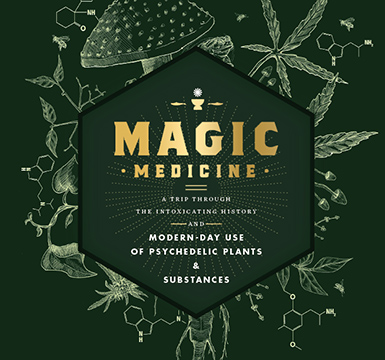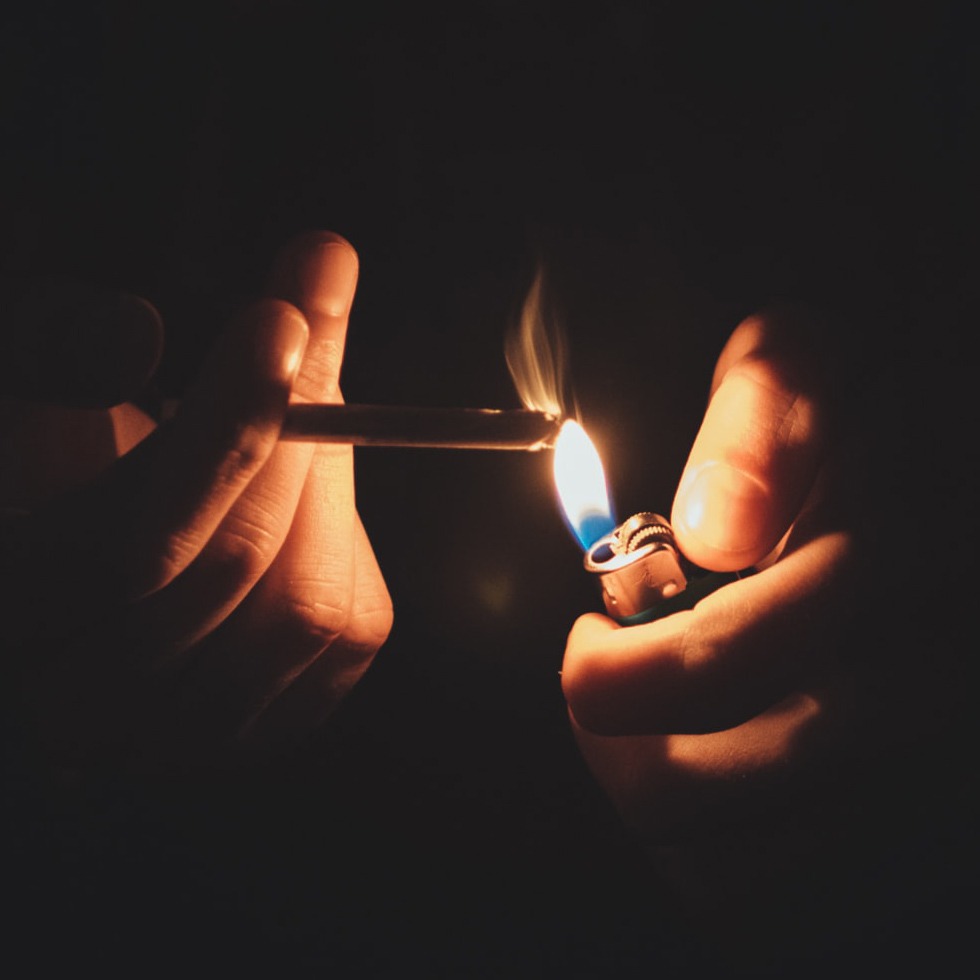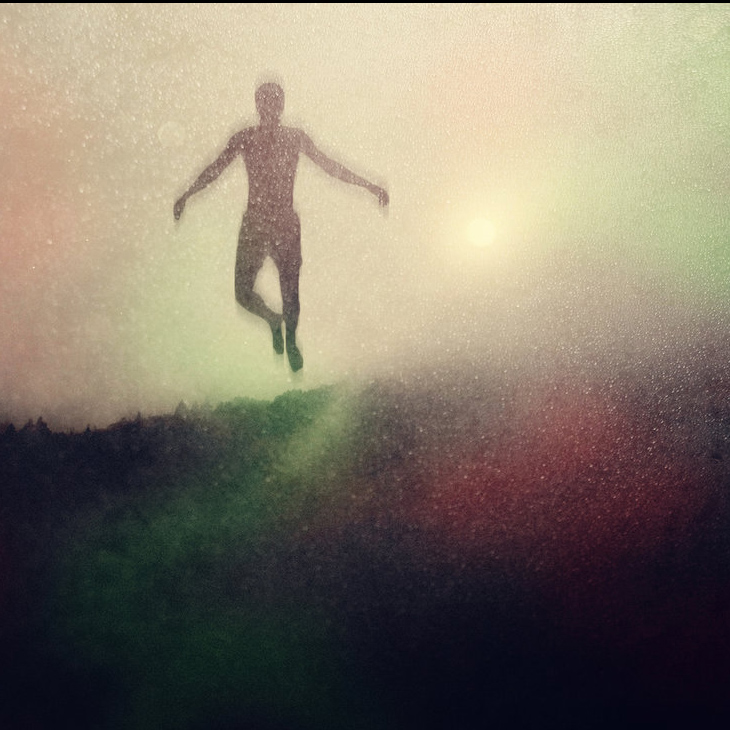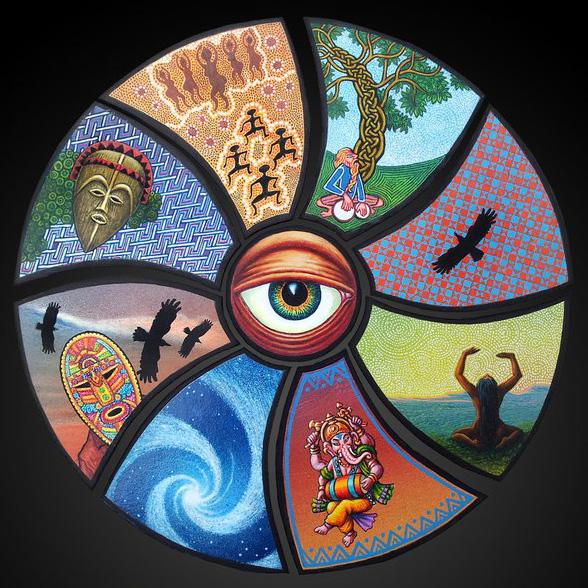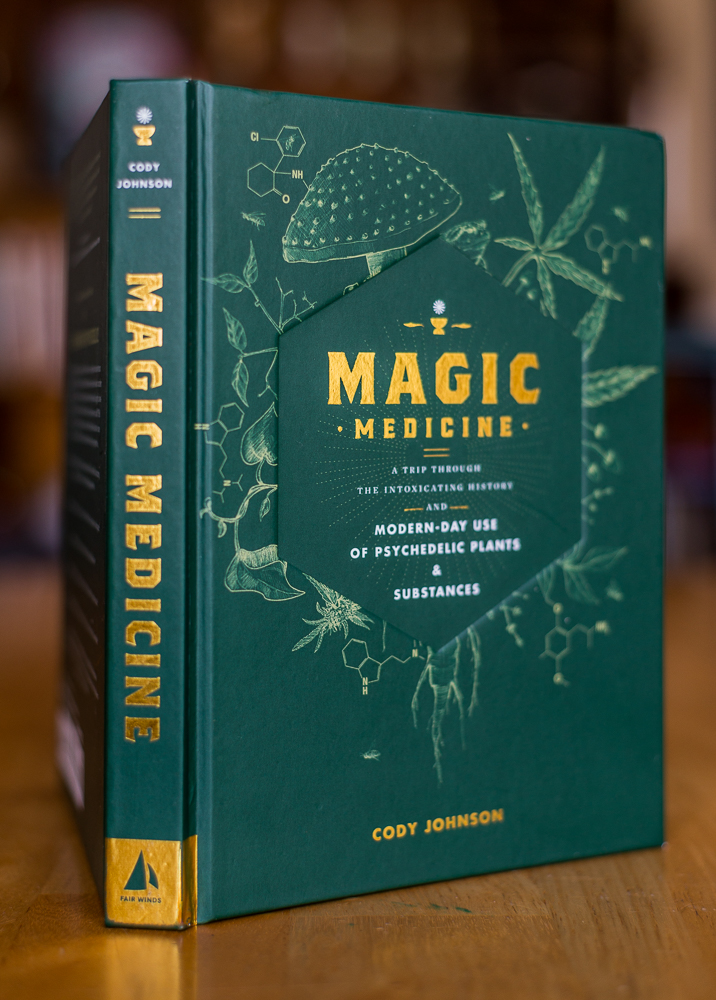The following essay by Martin W. Ball is an edited excerpt from his book, The Entheogenic Evolution: Psychedelics, Consciousness and Awakening the Human Spirit, published by Kyandara Publishing in 2008. It was previously published on Reality Sandwich. For more information, visit martinball.net.
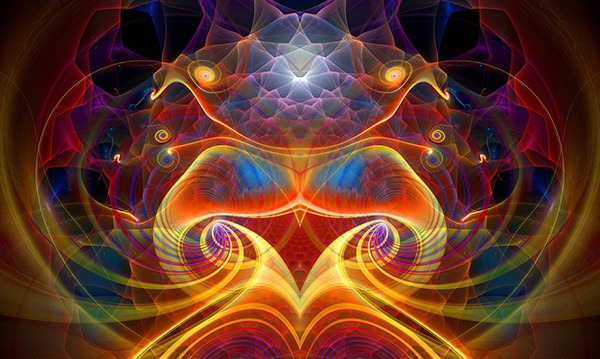
Spiralling Within, a fractal artwork by author Martin W Ball
The true heart of any religion or spiritual tradition is direct spiritual experience. It is from the immediate experience of the sacred that traditions arise, grow, and take on a life of their own as institutions and systems of belief. Yet without that initial spiritual experience, the inspiration that originally gave rise to the tradition, there is very little to base the tradition upon.
It isn’t difficult to see that this basic proposition is true. Of the “great” traditions of the world, meaning the more popular and well-established traditions, we find persons who were deeply immersed in direct spiritual experience. In the Judaic tradition, we find imposing figures such as Moses, who communed with God on the mountaintop, directly receiving messages and instructions from the beyond. Later, in the Christian tradition, we have the figure of Jesus, realizing and experiencing his own divinity. More recently, we find Mohammed in the Islamic tradition with his ecstatic flight to heaven to commune with Allah.
To the East, many more examples abound. In Buddhism we have the mystical figure of the Buddha, enlightened through meditation under the Bodhi tree. In the Taoist tradition, we find the sage of Lao Tzu and his work, the Tao Te Ching. The Hindu and Jain traditions also have countless significant mystics and saints, all inspired by their personal enlightenment experiences.
From the direct experiences of mystics, shamans, sages and saints, prophets and holy people, come the teachings and practices that become codified as religious and spiritual traditions and are then taught to others and passed on across cultures and history. But, at the root, at the very heart, we find inspired individuals who glimpsed and felt something of the sacred that impacted upon them so profoundly that they felt compelled to share their experiences and teachings with others, providing them with a path and methodology for experiencing the sacred themselves.
Something sorely missing from our legal protections is any recognition of the significance of direct spiritual experience itself.
In U.S. law, religion has largely been defined according to the concepts of belief and practice. Coming from the Western and Christian traditions, where belief and right practice of worship have been overwhelmingly emphasized over any form of direct spiritual experience, U.S. law sees “freedom of religion” as referring primarily to the freedom to believe and secondarily to the freedom to practice. According to U.S. law, we are all free to believe whatever we want. No one can force us to believe any particular dogma or religious teaching, and if we choose, we can believe in nothing at all. As for practice, we are free to practice our religions however we see fit, as long as those practices do not interfere with the greater interests of the State, violate laws, or impinge on others’ Constitutional freedoms and rights.
However, something sorely missing from our legal protections is any recognition of the significance of direct spiritual experience itself. One can believe or practice however one may like, but that does not mean that one will necessarily have any kind of direct spiritual or mystical experience. In fact, given the general spiritual disenchantment currently plaguing the West, it isn’t a stretch to say that all our emphasis on correct belief and practice has largely cut us off from any kind of direct spiritual experience, which explains the strong attraction Westerners have to Eastern and Indigenous traditions where the emphasis is on experience. We in the West are largely starving for spiritual experience and a re-enchantment of our experience and view of the world and of ourselves.
Direct spiritual experience is the most intimate aspect of our religious freedom and is central to our ability to freely explore our own spiritual natures.
Not only have many sought to find this re-enchantment through Eastern and Indigenous traditions, but also through the use of psychedelics and entheogens. However, these agents of spiritual experience and awakening are largely illegal in the West, making those who would use the sacred plants to find their connection to the sacred into criminals and outlaws. We are told that while we are free to believe that visionary medicines are sacred and a connection to the divine, we are not permitted to practice, as our practice is in conflict with other legal priorities, such as the so-called “war on drugs.”
How would things be different if not just belief and practice were protected by law, but if spiritual experience itself were also protected? What I would like to argue is that direct spiritual experience is the most intimate aspect of our religious or spiritual freedom and is central to our ability to freely explore our own spiritual natures. In short, the primary argument here is that it is time to reframe the discussion. Direct spiritual experience should be a fundamental human right, and any law that would counter that right should be discarded as decidedly undemocratic and as curtailing our basic freedom as spiritual beings.
Belief is a decidedly poor foundation upon which to build a spiritual or religious tradition, especially in the modern world. Many of the beliefs upon which Western traditions are built don’t hold up well against rationalism and scientific inquiry, especially when taken in their most dogmatic and fundamentalist forms. Much of the current debate in the West over science versus religion centers on this problem of belief and it promotes sloppy thinking on both sides. Religious leaders blindly dismiss scientific evidence when it conflicts with their cherished beliefs, wearing virtual blinders over their rational thinking, and scientists can be equally as naive, equating religion with mythological thinking and superstition and therefore needing to be dismissed as irrational and ultimately unreal. Both sides of this debate largely miss the fact that spiritual experience itself need not be based on any beliefs and that there are, in fact, many similarities between the claims of mystics, shamans, and scientists regarding the nature of reality when they are speaking from their direct experience rather than just repeating worn-out dogmas and long-cherished beliefs about reality and the way of the world.
Altered states of consciousness, whether plant-induced or not, have been central to the development of spiritual and religious traditions from the dawn of time.
But what if we were truly free to choose how we wanted to explore our own spiritual natures, free from the constraints of dogmatic beliefs, strict ritual liturgies, and patronizing laws? What if we could, of our own free will, decide that we want to follow the path of entheogenic spirituality and use the sacred visionary medicines to enhance and explore our spiritual nature and cultivate our spiritual experiences as we saw fit? How would our society be different? How might things look if we had sovereignty over our minds?
Many contemporary religious practitioners claim that entheogenic spirituality is not true spirituality, not true religious practice. Sadly, such claims reflect a fairly profound ignorance of human history, culture, and religion. Altered states of consciousness, whether plant-induced or not, have been central to the development of spiritual and religious traditions from the dawn of time. Dreams, trances, visions, and ecstatic states have formed the core of much of what has been passed down to us as religious traditions throughout history, and many of these altered states have been visionary plant-induced. This is an undeniable fact of history.
Without the altered states of consciousness and spiritual experiences of shamans and mystics, religion, as we know it, would simply not exist.
Religions in the West have largely feared shamans and shamanic practice. Mysticism in the West hasn’t necessarily fared much better, but to some extent it was tolerated, though the Catholic Church branded some mystics as heretics and the mystery traditions were shunned and denigrated. Shamans were greeted with outright hostility, however, often being the targets of zealous Christian missionaries. Throughout Europe and the New World, countless shamans, witches, and healers were slaughtered at the hands of Christians, bent on stamping out any vestige of direct spiritual experience or practices that might be in conflict with the teachings of the Christian church. In Europe, that meant that thousands, if not millions, of women who practiced “witchcraft” were burned at the stake or otherwise killed. In the Americas, indigenous peoples were subjected to the brutality of genocide, ethnic cleansing, and the intentional murder of their shamanic leaders. According to Christian dogma, by definition, shamanic practitioners had to be devil worshipers, and therefore their murders were justified, along with those who followed them or refused to accept the Christian teachings, beliefs, and practices.
While shamans and shamanic traditions fared better in the East, they were not free from persecution from the spread of other religions. Many shamanic traditions were incorporated into Eastern religious traditions, such as the more trantric schools of Buddhism and Hinduism, but even in these cases there was persecution of shamans. As trantric Buddhism spread through Asia, local shamans, who were often female, were treated as superstitious and ignorant. While they were not necessarily killed outright, as shamans and healers were at the hands of Christian missionaries, their practices were seen as less sophisticated and advanced than the complex trantric traditions that were largely male-dominated. It is only now that certain areas of Asia in the former Soviet Union are re-embracing shamanism, such as in the Republic of Tuva and Mongolia, both of which were heavily missionized by male Buddhist lamas.
It was not just Christians who were intolerant of shamans and other similar spiritual healing traditions in the West. With the advent of the Enlightenment and the Scientific Revolution, other dismissive and belittling attitudes towards shamans and spiritual experience in general became prominent in the West, the effects of which we are still living with today. In many ways, the Scientific Revolution was a reaction to the medieval scholasticism of Christian theologians, where all knowledge and proclamations of truth had to be subsumed under Christian dogma. Relying largely on Platonic and Aristotelian philosophy, Christian theologians made their models of reality conform to their pre-existing philosophical and theological postulations, rather than letting the evidence decide their models. For example, many religious leaders refused to look through Galileo’s telescopes because the direct observation that the moon had varied features, as opposed to being a perfect, incorruptible sphere, as taught by Aristotelian philosophy and cosmology, would contradict their view of the world and universe. Scientists and rational thinkers, on the other hand, developed the relatively new view that observations about reality should inform our views on reality, not necessarily the other way around. If the moon is observed to be imperfect, then it is the theory that the moon is incorruptible that has to change, rather than the data should be denied and hidden away, as was the practice of the Church when observable facts contradicted their doctrine and theology.
The European patriarchy was clearly focused on removing the female non-Christian practitioners of direct spiritual practice but was far less concerned with the elite males who served the existing patriarchal power structure.
Something quite significant is that, during the time of the Inquisition when the Catholic Church was busy exterminating local folk healers, the magicians, alchemists, and astrologers were largely left untouched and unharmed. A clear distinction was made between the “high” magicians and other esoteric practitioners who often taught at medieval universities and counseled heads of state and the aristocracy, and the “low” folk healers, midwives, “witches,” and other local magical practitioners, most of whom were women. In short, the European patriarchy was clearly focused on removing the female non-Christian practitioners of direct spiritual practice but was far less concerned with the elite males who served the existing patriarchal power structure.
Thus the male elite survived the Inquisition and, through various transformations, became the leaders of the scientific revolution. However, with the growing success of “science” and the “scientific method” of careful observation, accumulation of data, and theory formation and revision, the more subjective aspects of magical practice were left aside and eventually relegated to the subjectivity of “religion,” with the realm of objectivity left for science. With the philosopher Rene Descartes, we get a clear articulation of this view through his dualistic philosophy, clearly separating mind from body and the spiritual from the physical. Here, all things spiritual, subjective, and non-physical are given to religion, with observation of material facts through rational observation belonging to the province of science and scientific observation and theory building.
The result was that rationality and observation were seen as not only objective, and therefore verifiably true, but also as distinctly masculine traits. Under the scientific lens, nature was seen as feminine and the rational, male mind was viewed as the ultimate tool for unraveling the secrets of nature and providing domination over nature. In this sense, the scientific community reflected the same patriarchal misogyny of the Church in dominating women folk healers, making the feminine secondary and subject to the primacy of the masculine. And not only was nature feminine, but through masculine rationality, men were, in theory, able to dominate and control nature, bending “her” to their will.
Members of Western societies are basically forced to choose sides in this invented debate – either “objective truth” or “subjective belief” wins the day, with very little supposed meeting ground between the two.
We are still living with the effects of these forces of European society many hundreds of years later. The entire debate of the relationship or conflict between “religion” and “science” still bears the marks of this original divide. Science is seen to objectively deal with questions of the physical, while religion, at least according to scientists, should confine itself to the non-material and spiritual (which, according to many scientists, doesn’t really exist anyway, so religion is therefore strictly mythical and imaginary, or simply a function of belief and practice with no factual connection to observable reality). So on the one hand, we have objective, factual science that produces knowledge through supposedly purely objective means, and on the other, subjective, belief-based religion that does not promote subjective experience as much as it promotes adherence to beliefs and practices. When there is a conflict between the two views, as there often is, members of Western societies are basically forced to choose sides in this invented debate – either “objective truth” or “subjective belief” wins the day, with very little supposed meeting ground between the two. In short, we have either “knowledge” or “faith,” the former based on objectivity and the later on blind belief.
Neither position leaves much room for subjective experience. According to the scientific view, subjective experiences cannot be objectively observed, and therefore are not open to questions of truth, theory building, model making, or any of the other standard procedures for producing “knowledge.” Under this view, while a person may claim to have had a powerful spiritual experience, this is still theoretically subjective and therefore not amenable to the scientific worldview or system of practice. On the other hand, any subjective spiritual experience that does not fit within the confines of prescribed religious belief or doctrine is relegated to the bin of heresy, delusion, or devil worship.
These views were held fairly universally in the West until only relatively recently. In recent decades Westerns have paid far more attention to the practices, knowledge, and techniques of spiritual practitioners such as shamans, yogis, trantrikas, and others. It is becoming increasingly clear that shamans, for example, hold a vast repository of knowledge relating to nearly all supposedly “scientific” subjects, such as pharmacological properties of plants, ecological knowledge, astronomical knowledge, biology, medicine, and more. While there is still some dismissal of shamanic knowledge by mainstream rationalists and objectivists, overall, more respect for traditional knowledge is generally being shown within the larger society.
The same is also true of spiritual traditions that emphasize the cultivation of personal spiritual experience. Disillusioned by the hollow and empty teachings of the Western religions that emphasize largely irrational belief in the face of supposed scientific facts, many Westerners have turned to Eastern religions in the search for genuine spiritual experience and meaning. Taoism, Buddhism, Hinduism, yoga, tai chi, chi gong and many other Eastern practices have found willing and ready practitioners in the West, who find a different emphasis in such traditions than what they have been traditionally offered in the West. Here, the emphasis is on each individual practitioner coming to his or her own spiritual realizations through a practice of meditation or spiritual exercise. While they may still be taught various beliefs in conjunction with a given tradition, the overwhelming emphasis is on direct experience itself.
Entheogenic spirituality is viewed as being make-believe, imaginary, and hedonistic. It is not considered a real spiritual path.
The same is largely true for Western science’s appreciation for shamanic knowledge. Pharmaceutical companies are scrambling to learn the herbal wisdom of the shamans, but few are actually learning the methods of altered states of consciousness through which shamans have come to their hard-earned wisdom. While the West is genuinely recognizing that shamanic and traditional wisdom cannot be universally reduced to myth, legend and pre-scientific irrationality, the methods and techniques of shamans are still viewed as subjective and unscientific and therefore not necessarily worthy of emulation. The result is that while the physical and practical side of their knowledge is being widely accepted and appreciated at this time, their methods are still thought to be too subjective to be considered scientific.
We can see a shift toward the value of direct spiritual experience, however. Because this has been sorely lacking in contemporary Western traditions, Westerners have sought their sources of direct spiritual experience elsewhere. However, even among those who seek to follow a mystical or shamanic path, there is still some fear and denigration of visionary medicines as genuine spiritual tools. Oddly, many contemporary Western shamanic practitioners claim that genuine shamanism does not use visionary plants, despite the historical and cultural fact that visionary medicines are used or have been used by countless shamanic cultures across the world. Many mainstream “shamanic practitioners” claim that their practice is “drug free” and instead make use of “shamanic drumming” and other widely practiced New Age-style techniques such as visualization, guided imagery, and the like. Similarly, those involved in meditation traditions often proclaim that visionary plants are “short-cuts” or “false awakenings,” and that only through years of dedicated meditation and study can one have a genuine spiritual experience or mystical awakening. So, in both cultural streams, there is still resistance to visionary plants and medicines, despite their place in both history and contemporary shamanic cultures.
Ever since Timothy Leary and his colleagues at Harvard unleashed LSD on the West, we have been living with the repercussions of an irrational, dogmatic, and I would argue, unconstitutional “war on drugs,” which has caught many of the sacred visionary medicines in its net.
The result is that, even among so-called “alternative” spiritual practitioners, there is still a fairly strong bias against visionary plants and medicines, sometimes even more so than among mainstream culture, as efforts are made by these alternative traditions to distinguish themselves from the more “questionable” practices of entheogenic spirituality. Thus despite the cultural shift, entheogens are still underground as spiritual tools in the West, and remain largely illegal to use, and even when legal, are still regarded with suspicion, and are treated as somehow illegitimate or not genuine. Entheogenic spirituality is viewed as being make-believe, imaginary, and hedonistic. It is not considered a real spiritual path.
When it comes to the spiritual use of visionary plants, spiritual seekers find that not only do they have to fight against the mainstream of Western history and culture, but also have to fight against restrictive and often discriminatory laws concerning the use of visionary plants and medicines. Ever since Timothy Leary and his colleagues at Harvard unleashed LSD on the West, we have been living with the repercussions of an irrational, dogmatic, and I would argue, unconstitutional “war on drugs,” which has caught many of the sacred visionary medicines in its net. Those who would seek to expand their horizons by seeking genuine direct spiritual experience through entheogens have to risk not only social scorn and punishment, but also the threat of jail and the prospect of losing everything in their lives, including their homes, property, families, jobs, and place within society.
Why do we not have a legally protected right to pursue and cultivate direct spiritual experience however we see fit, as long as our actions do not cause any immediate or direct harm to others?
How can this be the case? Even if we want to punish people for taking drugs, why is it that the ceremonial and sacramental use of visionary plants and medicines is largely illegal? Why isn’t an individual’s choice of sacrament a protected activity under our laws? Why do we not have a legally protected right to pursue and cultivate direct spiritual experience however we see fit, as long as our actions do not cause any immediate or direct harm to others?
From the brief overview of historical forces outlined above, it is not difficult to see that anyone in the West wanting to use a visionary sacrament would have a great deal of historical, social, and cultural inertia to overcome in order for their choice to be accepted by mainstream institutions. But it is not just acceptance that we are considering here, it is the actual legal recognition of a right to practice legitimate spiritual pursuits as one sees fit. Of course, our country’s laws arise from the same historical stream as our scientific and religious institutions; so the views of science and religion directly impacted how we conceive of Constitutionally protected activities and how we define which categories of choices deserve the protection of law.
While it is true that the government has certainly refrained from compelling our allegiance to any particular religion, it is also true that it is the government that gets to decide which practices and institutions merit the designation of religion in the first place.
When one considers the legal issues surrounding the sacramental use of entheogens, it is easy to see that the significance of cultivating direct spiritual experience is nowhere taken into consideration. Rather, we are confronted with issues of “belief” and “practice,” and rather narrow definitions of what characterizes freedom in the pursuit of a religious or spiritual practice. To understand how this functions in contemporary American society, let’s turn to examine some of our legal institutions and strictures and see how they impinge upon the right to explore spirituality as one sees fit.
Let us start with the United States Constitution and the supposed freedoms that it guarantees for all U.S. citizens. As the First Amendment reads: “Congress shall make no law respecting an establishment of religion, or prohibiting the free exercise thereof.” The first part of this amendment addresses the fact that European immigrants to the U.S. often came from countries that had official state religions, such as the Anglican Church of England. This amendment was created to insure that there would be no official religion of the U.S. (despite the claims of many evangelicals today that the U.S. is a “Christian” country). In short, it reads that the federal government cannot require any U.S. citizen to belong to any particular religion, or to any religion at all. We are all free to believe and practice as we see fit and cannot be compelled into any particular religion, as had been the case in Europe. The second part limits the government’s ability to interfere with whatever religious tradition we freely chose to become a part of, clearly stating that the government cannot interfere with one’s ability to practice a chosen religion. This amendment immediately reflects back on the experience of Europeans immigrating to the New World, many of whom came specifically seeking religious freedom due to the persecution they faced at home. The U.S. was to be the land of religious liberty where people could believe and practice however they saw fit according to their own conscience and desire.
To date, no one has ever successfully argued in U.S. court that his personal choice to use an entheogenic sacrament to cultivate his personal spiritual experience is protected by the Constitution.
Thus the First Amendment is not without its problems and is not as clear-cut a protection as it may seem. It is all the more problematic when one is looking at questions of “spiritual” practice as opposed to “religious” practice. This is especially true when one considers shamanism and mysticism. Neither shamans nor mystics need to be a part of any particular religion at all in order to pursue spiritual aims, and has often historically been the case in the West, shamans and mystics have been purposely excluded from our institutions of religion and religious practice. They can therefore constitute a class of spiritual practitioners who are not participating in any given “religion,” at least not as defined in U.S. law.
Given that our direct and immediate spiritual experience is the most intimate aspect of our beings, perhaps even more intimate than our physical bodies, our right to direct spiritual experience should be protected, and not just our right to participate in a religion of our choice.
If shamans and mystics and their practices already fall somewhat outside the definitions of protected activities under U.S. law, we can only imagine how much more challenging it would be for a solitary practitioner of entheogenic spirituality to make a case that his or her practices should be protected by the Constitution. Not only would such a person have to argue for why their practices are “religious” in the first place, but also explain why laws created to prohibit the use of illegal “drugs” should be disregarded in some cases in order to protect “religious freedom.” To date, no one has ever successfully argued in U.S. court that his personal choice to use an entheogenic sacrament to cultivate his personal spiritual experience is protected by the Constitution. And unless we carefully examine what we are protecting and how, it is unlikely that anyone ever will succeed in making such an argument before the U.S. Supreme Court.
It is my contention that direct spiritual experience should be a protected category of activity as defined and delineated in the U.S. Constitution or other similar political documents. And even beyond the U.S., I propose that it be written into a fundamental declaration of human rights at the United Nations, applicable to all nations of the world. Given that our direct and immediate spiritual experience is the most intimate aspect of our beings, perhaps even more intimate than our physical bodies, our right to direct spiritual experience should be protected, and not just our right to participate in a religion of our choice. There is a difference between being spiritually aware and active and being religious, but we have absolutely no protections for spiritual experience, even though our Constitution protects religious freedom. And even when we protect religious freedom, there are other considerations that are thrown into the mix so that one can never assume that just because a practice or belief is part of a religion that it will be protected, as will be shown in the analysis of U.S. Supreme Court case given below.
Any argument that use of entheogens cannot be spiritual is clearly contradicted by the overwhelming evidence of world history and human cultures.
But to see how the Supreme Court deals with Constitutional issues surrounding entheogen use, consider the “Smith” case that was decided in 1990. In this case an employee for the state of Oregon lost his job and his benefits when he admitted to using peyote in a Native American Church ceremony. Smith made the case that he was merely exercising his Constitutionally protected right to the free exercise of religion, as guaranteed by the first amendment. While peyote may be a schedule I illegal drug in the eyes of U.S. law, as a member of a legally recognized church that makes use of the peyote cactus as a sacrament, he felt that he was unjustly punished by the state of Oregon. The state of Oregon, on the other hand, made the case that peyote is illegal in Oregon under federal law and the state was merely fulfilling its duty to apply the law equally to all citizens. Smith’s argument for religious freedom was trumped by the state’s interest in upholding federal and local drug laws.
Smith lost in Oregon, and eventually the Supreme Court took up the case. The result was that Smith lost and the Court found on behalf of the State of Oregon. Justice Antoine Scalia wrote the majority opinion for the court, stating the following:
The free exercise of religion means, first and foremost, the right to believe and profess whatever religious doctrine one desires. . .
[The respondents] assert that ‘prohibiting the free exercise [of religion]’ includes requiring any individual to observe a generally applicable law that requires (or forbids) the performance of an act that his religious belief forbids (or requires).
It is a permissible reading of the text . . . to say that if prohibiting the exercise of religion . . . is not the object of the [law] but merely the incidental effect of a generally applicable and otherwise valid provision, the First Amendment has not been offended.
To make an individual’s obligation to obey such a law contingent upon the law’s coincidence with his religious beliefs, except where the State’s interest is ‘compelling’ – permitting him, by virtue of his beliefs, to become a law unto himself, contradicts both Constitutional tradition and common sense.
If the ‘compelling interest’ test is to be applied at all, then, it must be applied across the board, to all actions thought to be religiously commanded. Moreover, if ‘compelling interest’ really means what it says (and watering it down here would subvert its rigor in the other fields where it is applied), many laws will not meet the test. Any society adopting such a system would be courting anarchy . . . The First Amendment’s protection of religious liberty does not require this.” (Employment Division of Oregon v. Smith, emphasis added)
If a person can lose his rights for participating in a legally recognized religion that uses a psychedelic sacrament, then what real protection is there for any religion?
Scalia’s decision gave rise to some profound questions, the most significant of which was: if a person can lose his rights for participating in a legally recognized religion that uses a psychedelic sacrament, then what real protection is there for any religion? Is there any substance at all to the First Amendment, or can the government simply trump religious freedom whenever a religion’s practices come into conflict with existing U.S. law? Here, the burden was placed on Smith to show that the government should uphold his First Amendment rights and not the other way around. The government did not have to show why drug laws were more inviolable than the Constitution. Given that this is was the case, what teeth does the Constitution then have to limit the actions of the government? According to Scalia, apparently none at all, for it would lead to “anarchy.”
The result of Scalia’s decision in Employment Division vs. Smith was the creation and enactment of the Religious Freedom Restoration Act of 1993 as created by Congress and signed into law by President Bill Clinton. The Religious Freedom Restoration Act (RFRA) was a direct response to this frightening Supreme Court decision that seemed to strip the Constitution of any real ability to protect the rights of citizens in the face of government interference with their granted liberties. The main thrust of the RFRA is that the burden of proof and argument must be placed on the government in religious liberty cases, rather than the reversal that Scalia argued for in placing the burden on the one whose rights were violated. Specifically, the RFRA reads:
(a) FINDINGS: The Congress finds that–
(1) the framers of the Constitution, recognizing free exercise of religion as an unalienable right, secured its protection in the First Amendment to the Constitution;
(2) laws ‘neutral’ toward religion may burden religious exercise as surely as laws intended to interfere with religious exercise;
(3) governments should not substantially burden religious exercise without compelling justification;
(4) in Employment Division v. Smith, 494 U.S. 872 (1990) the Supreme Court virtually eliminated the requirement that the government justify burdens on religious exercise imposed by laws neutral toward religion; and
(5) the compelling interest test as set forth in prior Federal court rulings is a workable test for striking sensible balances between religious liberty and competing prior governmental interests.
(b) PURPOSES: The purposes of this Act are–
(1) to restore the compelling interest test as set forth in Sherbert v. Verner, 374 U.S. 398 (1963) and Wisconsin v. Yoder, 406 U.S. 205 (1972) and to guarantee its application in all cases where free exercise of religion is substantially burdened; and
(2) to provide a claim or defense to persons whose religious exercise is substantially burdened by government.
SEC. 3. FREE EXERCISE OF RELIGION PROTECTED.
(a) In General: Government shall not substantially burden a person’s exercise of religion even if the burden results from a rule of general applicability, except as provided in subsection (b).
(b) Exception: Government may substantially burden a person’s exercise of religion only if it demonstrates that application of the burden to the person–
(1) is in furtherance of a compelling governmental interest; and
(2) is the least restrictive means of furthering that compelling governmental interest.
(c) Judicial Relief: A person whose religious exercise has been burdened in violation of this section may assert that violation as a claim or defense in a judicial proceeding and obtain appropriate relief against a government. Standing to assert a claim or defense under this section shall be governed by the general rules of standing under article III of the Constitution.”
The general role of entheogens as sacraments as a protected category of activity still has not been addressed by Congress.
The basic assumption made under U.S. law is that “religion” is a protected category whereas individual spiritual practice that is not directly tied to a “religion” is not even taken into consideration as a possible protected category.
One limitation with the RFRA is that we are still dealing with the concept of “religion” and do not, as of yet, have any legal guidelines for addressing questions of individual spiritual practice. The basic assumption made under U.S. law is that “religion” is a protected category whereas individual spiritual practice that is not directly tied to a “religion” is not even taken into consideration as a possible protected category. Therefore the RFRA does not seem to have much applicability for those interested in arguing that their personal and non-religious, though spiritual, use of entheogens should be a protected class of activity.
What if Smith had not been a member of the Native American Church and simply an individual who chose to consume peyote as a sacrament for personal spiritual growth and experience? Would the RFRA have helped him? Most likely not, for then Smith would not have been able to argue that his practices were part of a “religion” per se, unless he wanted to make the argument that mysticism or shamanism, or even direct spiritual experience itself, were “religions.” None of these meet the general criteria for religion as defined in U.S. law, however, so it is unlikely that the court would have accepted his argument, for do so would be to open up the question of “anarchy” that Scalia wrote of in his opinion. With a “religion,” the court can look to what the professed beliefs and practices of the institution are and judge whether an individual is actually practicing that religion in accordance with its doctrines and traditions. When it comes to individual practice, the court has nothing to evaluate a person’s claim with and must either take the person’s word as genuine or dismiss it as an excuse. For example, virtually anyone could claim that his or her illegal use of entheogens was “spiritual,” but by what means would the court assess the validity of such a claim? How could they know that a person was genuine? By what means could they evaluate such a claim of legal protection? And furthermore, why would they bother, given that individual spiritual practice is not yet a protected category?
Of course all this would be obviated were the prohibition against entheogens to end, and this would be the easiest solution. We could simply recognize that competent adults are free to make up their own minds about what they choose to put into their bodies and for what reason and leave it at that. Entheogen use could be made legal, regulated to prevent minors from gaining access to entheogens, and used by freely consenting adults as long as that use did not cause any direct harm to others.
However, given that entheogen use is unlikely to be made legal at a general level any time soon, it would seem that attempting to reframe the argument about protected categories of practice, namely the proposal that we consider individual spiritual practice and direct spiritual experience as protected categories, might be a more fruitful avenue of addressing the issue. For entheogens could still be illegal as a general law, but their use for spiritual purposes could be made a protected category just as peyote consumption is still illegal, yet it is a protected activity for members of the Native American Church. With some amendments to the RFRA, or the introduction of a similar act that specifically addresses the centrality of individual spiritual experience, this could be a realistic goal. My proposal is that we need a clear statement of rights along the lines of what I outline below (keeping in mind that I am neither a Constitutional scholar nor a lawyer or legislator).
The Universal Declaration of the Human Right to Direct Spiritual Experience
We recognize the following:
Human beings are innately spiritual. The human quest for spiritual meaning and experience is fundamental to the human experience. Personal spiritual experience is furthermore understood to be one of the most intimate aspects of person’s identity, sense of self, and worldview.
While the human quest for spiritual meaning and experience can be institutionalized through the formation and continuation of religious traditions, the drive for spiritual meaning and experience is not limited to religious activity or membership per se.
Religious practice and membership is not identical to spiritual experience. Religion, as a social institution, provides opportunity for like-minded people to gather together in groups to collectively express their beliefs in the context of shared practices. Religion provides structures of ritual, ceremony, religious teachings, and a community of similarly-oriented individuals. Within the context of a religion, persons may be afforded the opportunity for direct spiritual experience, but this is not necessarily the case. As direct spiritual experience is primarily an individual matter, the locus of spiritual experience is necessarily the individual, and not a religious tradition or institution.
While religious membership and activity is universally recognized as a fundamental human right and is protected by law, individual pursuit of spiritual experiences has not been afforded the same legal protections. This act seeks to correct this omission from the list of universal human rights.
Because the locus of direct spiritual experience is the individual, protections for individual spiritual experience must be afforded directly to individuals, rather than to the institutions in which they practice. As a result, protection for direct spiritual experience is not limited to individuals who are members of religious traditions, but extend equally to all individuals, regardless of religious affiliation or lack thereof.
All practices that contribute to an individual’s cultivation of direct spiritual experience are hereby affirmed to be protected by international laws recognizing universal human rights, with the condition that such practices do not violate any other universally recognized human rights of other persons, such as the rights to life, liberty, and pursuit of happiness.
In recognition of this universal human right to direct spiritual experience, it is hereby decreed that no government shall persecute or punish any individual who chooses to pursue the cultivation of direct spiritual experience in a manner that is respectful of the human rights of others.
It is furthermore recognized that the universal human right to direct spiritual experience provides a legal defense for those who would choose to pursue the use of entheogenic agents in their quest to achieve direct spiritual experience. While recognizing that governments have a vested interest in reducing the impact of recreational drug use and abuse within their territories, drug laws, in and of themselves, are not sufficient grounds for barring the legitimate use of entheogenic sacraments for personal spiritual experience.
The burden of proof for the limiting of any activity that can be construed as the cultivation of direct personal spiritual experience is clearly placed on any regulating body, governmental or otherwise. The universal right to direct spiritual experience will be afforded to all equally without any interference by regulating bodies unless said regulating bodies can demonstrate beyond any doubt that the activities of any individual is in violation of the fundamental human rights of another person or persons. Claiming that an individual’s practice, such as might be the case with the use of entheogens, is against any law, is not sufficient grounds for disallowing the practice. The standard for the burden of proof is to be judged solely on how any given practice violates the rights of others.
It is my hope that the issues raised and arguments provided in this essay demonstrate why such a declaration of human rights is not only necessary, but also valid and reasonable as well. If we truly want to be free, then it is only reasonable that we be afforded our freedoms to pursue our spiritual connection to the divine however we may see fit, as long as our practices do not interfere with the rights of others. Obviously, such a claim could be made for the use of entheogens in general, and not just confined to a spiritual context, for just as our pursuit of spiritual consciousness and experience should be a fundamental human right, so should our experience of any level of consciousness that does not impinge on the rights of others be so protected. However, as I am primarily concerned with spiritual consciousness in this essay, I have chosen to focus on this more specific case of rights here. I am certainly of the view that people should be free to affect their consciousness as they see fit, regardless of whether it is done for spiritual purposes or not. However, given that religion is already a protected category, extending similar protections to direct spiritual experience might be an easier path to take, given current drug laws. Cognitive liberty in general is a fight worth fighting, and I fully support it. Yet, it is my contention that recognition of the legal right to spiritual experience might have the effect of obviating drug laws in their application to individuals who seek to use entheogens for spiritual experience.
Liked this post? Subscribe to my RSS feed to get much more!

